
OK, no question I am sensitive to this subject. The recent cancer and more major rehab efforts in the not so distant past than I care to remember high light that sensitivity. But with what I realized just recently was over 40 years in endurance sports let me offer a few comments and more opinion yet..
I first noticed "enhanced athletes" when one of my climbing partners was light years beyond any of his peers in strength. He also had a health club membership that cost more than my monthly apartment rent while we were in our mid 20s. His personal coaching staff and trainer costs were way beyond the club's membership dues. Younger than me by a few years he had already successfully competed internationally in two different sports. He was gifted, talented, strong. and well supported financially. It was years later before I put two and two together and came up ( in my opinion) with the idea of his obvious use of performance enhancing drugs.
The same guy worked hard and was obviously talented as well. I've know a number of world class athletes over the years. But it was obvious even then what he was getting from his work outs was not what we were getting from ours.
Still it is only my opinion that my friend was using "dope" to enhance his own climbing. After all, how many enhance their own climbing by a little "weed" these days? Last trip to Index made it obvious many do. Red Bull, a triple expresso, Gu? Where does it start or end?
Herman Buhl used Dexedrine on Nanga Parbat. These days we haveliving at altitude to increase red blood cells or buying a bed chamber to simulate sleeping at altitude to increase red blood cells or blood doping to inject your own red blood cells. Diamox? Better yet Oxygen?
How many will take advantage of the IV option in the Grand Columbian Ironman distance race in September?
"
For all Iron and Super distances (Aquathlon included) athletes may optionally purchase an 1000 ml IV during registration for $35 that guarantees them accelerated post race hydration and accelerated recovery. The purchase will assure you a no hassle IV that will set you on course for a quick recovery. We will have medical staff waiting at the finish line to administer them."
http://trifreaks.com/grand-columbian-super-tri/
I know from experience how long it took me to fully recover physically from a sub 12 hr long tri course event. No question an IV would have helped that recovery. I used two "force feed" 1000m IVs after a nasty bit of food poisoning when I was still required to perform, for "better or worse". But how can you not consider that doping? The same (IV) is a common occurrence in the pro peloton btw and totally legal. And how do you decide when to do an IV and what to add to them. It is so easy to add something to an IV. I literally lived off nothing but IVs for 5 months last winter so I know some of what is possible once you start sticking needles in your body. Yes, that was just an IV, no food or water via the mouth for months. It isn't just a slippery slope but a quick road to hell if you view doping as "hell".
I have friends in the military who have commented about the use of "juice" used from Viet Nam to Iraq and Iran. And none of them were pilots.
http://www.csmonitor.com/2002/0809/p01s04-usmi.html
For any climb going past a 24hr c2c effort there are a lot of ways to chemically enhance your physical abilities if you are willing. Funny though as my only recovery for any climb has always been a hot shower, a good meal and some decent sleep. Even the massages I have always saved for after a hard bike or exceptionally hard run. Just never had the money for a massage when I was climbing hard.
Take a look around any big city triathlon or the local road races (bike or running). Sorry but IMO 60 year old men just don't finish in the top 10 or even top 20 of a 500 person race without being a past professional or a damn good collegiate athlete in their 20s. Even then top 10? Not on their own is my bet. The availability of drugs for the
geriatriccrowd these days is simply amazing and more common than you might think.
"Through the intelligent application of today’s performance enhancing drugs, we
no longer have to succumb to the natural stages of life. So long as that man is
willing to do his part by putting the required effort into his training &
nutrition, he will be able to stave off and even reverse the aging process on
both the inside and the outside."
http://www.ironmagazine.com//performance-enhancing-drugs-the-middle-aged-man/
http://www.prospectmagazine.co.uk/magazine/the-age-of-enhancement/
But then may be I am full of shit and no one really has any idea what the human body is capable of yet.
May be the world really wasn't flat after all. Imagine the possibilities.
http://www.runningandrambling.com//09/fast-old-guys-rule.html
Just food for thought.
Next? Back to the regular program of climbing and awesome gear.
 [images via Linus Bikes and Gazelle USA]
[images via Linus Bikes and Gazelle USA] [image viaGazelle USA]
[image viaGazelle USA] [image viaLinus Bikes]
[image viaLinus Bikes] One of my favorite things to do while sitting at the beach, is to watch the surfers.
One of my favorite things to do while sitting at the beach, is to watch the surfers.










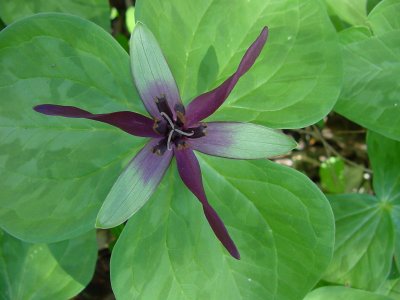



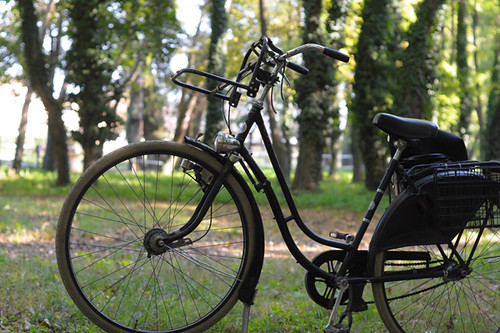
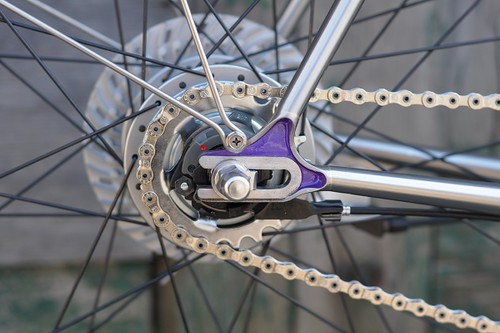




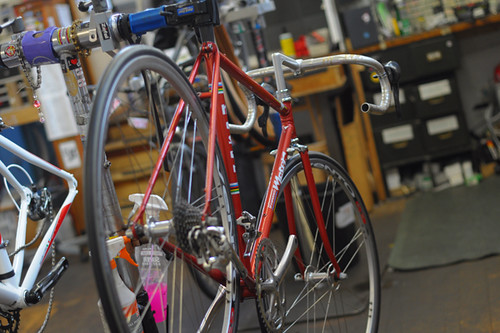 So I bought my Francesco Moser frame back from the person I sold it to, and built it up as a geared racing bike with modern components... despite having sworn off vintage roadbikes earlier. Yeah, I know. Allow me to provide some context:
So I bought my Francesco Moser frame back from the person I sold it to, and built it up as a geared racing bike with modern components... despite having sworn off vintage roadbikes earlier. Yeah, I know. Allow me to provide some context: For what it's worth, I still believe that it is not financially practical for a "civilian" (i.e. a person who is neither a wrenching enthusiast withspare modern groupsets lying around, nor someone withbike industry connections), to take on a project like this. However, I have not really been a "civilian" for some time: I am interested in bikes not only for personal use, but also for the sake of learning and writing about them onLovely Bicycle. And I do at this point have industry connections, as well as readers who are interested in making specific projects happen. All of these factors played a role here.
For what it's worth, I still believe that it is not financially practical for a "civilian" (i.e. a person who is neither a wrenching enthusiast withspare modern groupsets lying around, nor someone withbike industry connections), to take on a project like this. However, I have not really been a "civilian" for some time: I am interested in bikes not only for personal use, but also for the sake of learning and writing about them onLovely Bicycle. And I do at this point have industry connections, as well as readers who are interested in making specific projects happen. All of these factors played a role here.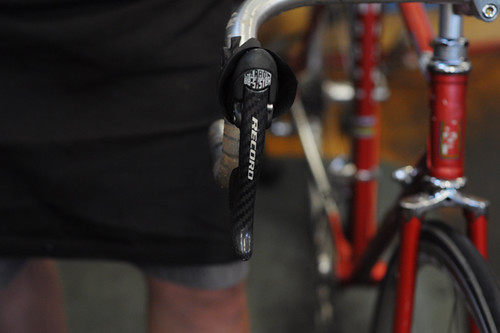 The second-hand components I received were a 9-speed Campagnolo Record drivertrain and levers circa (I believe) 1999 and a Campagnolo Vento wheelset of similar vintage. I already had the headset, stem, handlebars, tires and seatpost among my own spare parts. I bought a new bottom bracket, brake calipers, cable housing and bar tape at Harris Cyclery and they built up the bike for me.
The second-hand components I received were a 9-speed Campagnolo Record drivertrain and levers circa (I believe) 1999 and a Campagnolo Vento wheelset of similar vintage. I already had the headset, stem, handlebars, tires and seatpost among my own spare parts. I bought a new bottom bracket, brake calipers, cable housing and bar tape at Harris Cyclery and they built up the bike for me.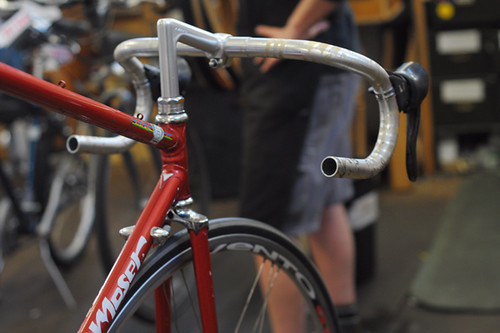 I am glad to have theMoserback; in a number of ways it is an even more unique bicycle than I thought.I hope to share my impressions in the coming week and fingers crossed that it doesn't start snowing in the meantime.Stay tuned, and a huge thank you to everyone who's helped me with this project!
I am glad to have theMoserback; in a number of ways it is an even more unique bicycle than I thought.I hope to share my impressions in the coming week and fingers crossed that it doesn't start snowing in the meantime.Stay tuned, and a huge thank you to everyone who's helped me with this project!

 Recently I scanned some miscellaneous documents for a project for my local genealogy society. Among them was this one. . .
Recently I scanned some miscellaneous documents for a project for my local genealogy society. Among them was this one. . . 
 The boutique bike shop is a relatively new phenomenon. It is designed to resemble a gallery space rather than a store, and often incorporates a coffee shop or a lounge area. The space features an open floor plan and minimalist decor. The stock of bicycles and accessories is kept intentionally sparse, so that each item receives individual attention. The staff usually have a personal connection to the shop. Instead of sales pitches, there is a calm curatorial demeanor. And the careful selection of bicycles tends to be on the high-end side.
The boutique bike shop is a relatively new phenomenon. It is designed to resemble a gallery space rather than a store, and often incorporates a coffee shop or a lounge area. The space features an open floor plan and minimalist decor. The stock of bicycles and accessories is kept intentionally sparse, so that each item receives individual attention. The staff usually have a personal connection to the shop. Instead of sales pitches, there is a calm curatorial demeanor. And the careful selection of bicycles tends to be on the high-end side.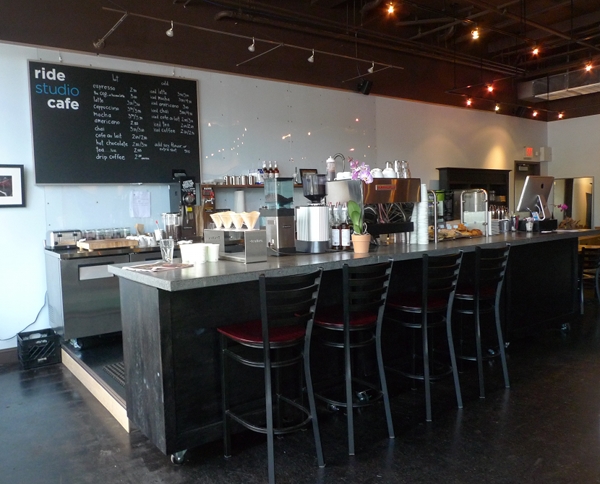 In the Boston area, the latest and much talked about bicycle boutique is the Ride Studio Cafe in Lexington, and I have stopped by a couple of times when cycling through the area.
In the Boston area, the latest and much talked about bicycle boutique is the Ride Studio Cafe in Lexington, and I have stopped by a couple of times when cycling through the area.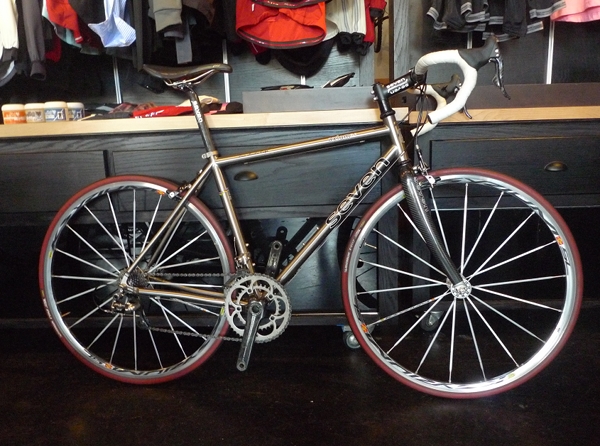 TheRide Studio Cafe sells mainly two types of bicycles. There are high end road bikes by the world-famous Seven Cycles that are built right here in Watertown, MA.
TheRide Studio Cafe sells mainly two types of bicycles. There are high end road bikes by the world-famous Seven Cycles that are built right here in Watertown, MA. And there are budget city bicycles (diamond frame and mixtes) from the San Francisco-based Public Bikes.
And there are budget city bicycles (diamond frame and mixtes) from the San Francisco-based Public Bikes. There is also apparel by Rapha and Campagnolo, as well as a variety of chamois creams and embrocation lotions.
There is also apparel by Rapha and Campagnolo, as well as a variety of chamois creams and embrocation lotions. In the back is a small workshop and storage area that is separated from the main floor, but accessible to visitors.
In the back is a small workshop and storage area that is separated from the main floor, but accessible to visitors.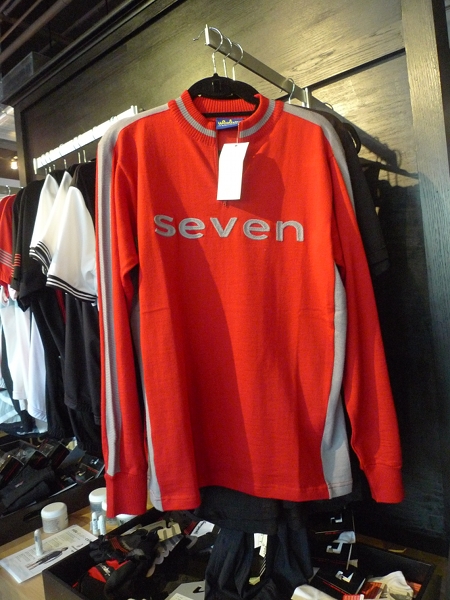 My first reaction upon entering the store, was an intimidated amazement upon seeing so many (titanium?) Seven bicycles in the same place, casually propped against walls here and there. Though I am not normally attracted to modern, non-lugged roadbikes, there is something about Seven Cycles that is just so impeccable that my eye cannot help but be drawn to them. I moved one of the bikes aside in order to photograph it, but got so nervous touching and positioning the beautiful, feather-light and extremely expensive machine, that after one picture with shaking hands I decided to put it back. Later it occurred to me that these bicycles are floor models and people probably test ride them all the time. Not sure whether I would be able to handle that, but the idea of test riding a Seven is tempting.
My first reaction upon entering the store, was an intimidated amazement upon seeing so many (titanium?) Seven bicycles in the same place, casually propped against walls here and there. Though I am not normally attracted to modern, non-lugged roadbikes, there is something about Seven Cycles that is just so impeccable that my eye cannot help but be drawn to them. I moved one of the bikes aside in order to photograph it, but got so nervous touching and positioning the beautiful, feather-light and extremely expensive machine, that after one picture with shaking hands I decided to put it back. Later it occurred to me that these bicycles are floor models and people probably test ride them all the time. Not sure whether I would be able to handle that, but the idea of test riding a Seven is tempting.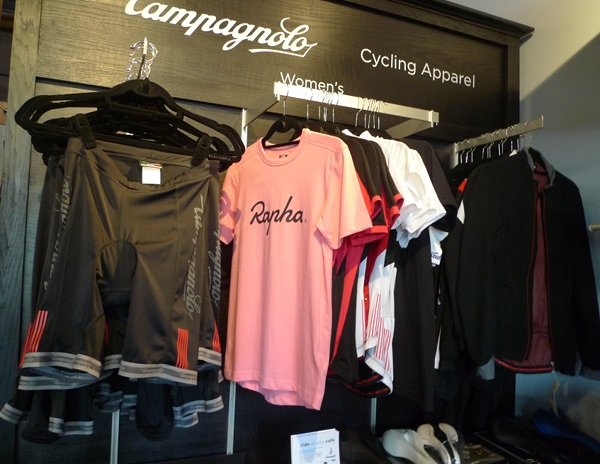 During the several months of its fledgling existence, theRide Studio Cafehas been a frequent topic of conversation among local bicycle enthusiasts, with speculations regarding its long-term feasibility. Is the population of Lexington and the surrounding towns really so affluent as to keep the boutique afloat with regular purchases of Seven bicycles and Rapha gear? And while the affordablePublic bikes are a good way to diversify, is it enough? If the answer to all of that is "yes", I think it is a fantastic sign of changing priorities among the segment of population with disposable income. Interestingly, the worse the economy is doing, the more of such boutiques are opening up. Could that indicate that more affluent suburban residents are choosing to purchase a silver Seveninstead of the usual silver Lexus
During the several months of its fledgling existence, theRide Studio Cafehas been a frequent topic of conversation among local bicycle enthusiasts, with speculations regarding its long-term feasibility. Is the population of Lexington and the surrounding towns really so affluent as to keep the boutique afloat with regular purchases of Seven bicycles and Rapha gear? And while the affordablePublic bikes are a good way to diversify, is it enough? If the answer to all of that is "yes", I think it is a fantastic sign of changing priorities among the segment of population with disposable income. Interestingly, the worse the economy is doing, the more of such boutiques are opening up. Could that indicate that more affluent suburban residents are choosing to purchase a silver Seveninstead of the usual silver Lexus
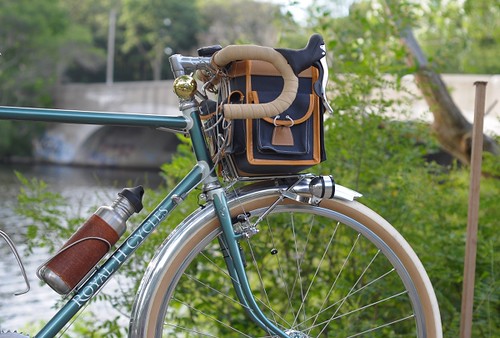 While dropbars tend to all look the same to those who are new to them, there are in fact lots of variations - most of which I find uncomfortable. This is particularly true of vintage bars, and it does not surprise me when others write to tell me they have trouble riding old roadbikes for this reason. What's uncomfortable about these dropbar designs, is their lack of flat "ramp" areas leading up to the brake hoods. When the brake lever is positioned on a dramatic slope, some report that their hands feel awkward and start to hurt on long rides. By contrast, famously comfortable handlebars - such as the Nitto Noodle and Randonneur models - have spacious, flat ramp areas that support the hands - both when on the hoods and behind the hoods. Rivendell explains about this feature here. And this comprehensive post about the difference in dropbar shape is definitely worth reading. My favourite flat-ramp dropbars so far have been the Grand Bois Maes (pictured above). They are similar to the Nitto Noodles, except that the ramps feel a bit longer and flatter, and the drops are parallel to the ramps. My hands absolutely love the feel of every part of these handlebars.
While dropbars tend to all look the same to those who are new to them, there are in fact lots of variations - most of which I find uncomfortable. This is particularly true of vintage bars, and it does not surprise me when others write to tell me they have trouble riding old roadbikes for this reason. What's uncomfortable about these dropbar designs, is their lack of flat "ramp" areas leading up to the brake hoods. When the brake lever is positioned on a dramatic slope, some report that their hands feel awkward and start to hurt on long rides. By contrast, famously comfortable handlebars - such as the Nitto Noodle and Randonneur models - have spacious, flat ramp areas that support the hands - both when on the hoods and behind the hoods. Rivendell explains about this feature here. And this comprehensive post about the difference in dropbar shape is definitely worth reading. My favourite flat-ramp dropbars so far have been the Grand Bois Maes (pictured above). They are similar to the Nitto Noodles, except that the ramps feel a bit longer and flatter, and the drops are parallel to the ramps. My hands absolutely love the feel of every part of these handlebars.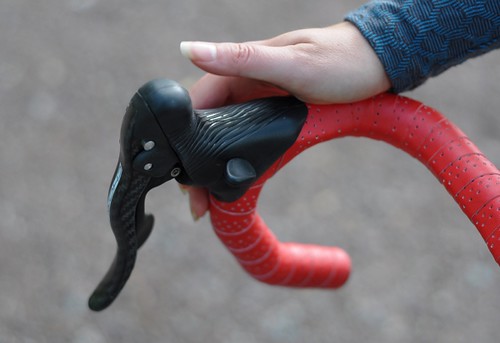 One thing that has me curious when it comes to the flat ramp design, is its origin. Until recently, my understanding was that it was a modern invention: a byproduct of the compact/ anatomic handlebars ushered in by the brifter era. It is often said that the Nitto Noodles basically combine this modern design with a vintage look, which is what makes them so popular. However, that does not jive with the description of the Grand Bois Maes bars as a remake of a 1950s Phillips Professionel model. Turns out that what many think of as a modern design is actually a mid-century design, which is rather fascinating. I would love to know the original inspiration behind this shape and why it was not more popular. After all, it is very difficult to find a set of vintage dropbars with flat ramps.
One thing that has me curious when it comes to the flat ramp design, is its origin. Until recently, my understanding was that it was a modern invention: a byproduct of the compact/ anatomic handlebars ushered in by the brifter era. It is often said that the Nitto Noodles basically combine this modern design with a vintage look, which is what makes them so popular. However, that does not jive with the description of the Grand Bois Maes bars as a remake of a 1950s Phillips Professionel model. Turns out that what many think of as a modern design is actually a mid-century design, which is rather fascinating. I would love to know the original inspiration behind this shape and why it was not more popular. After all, it is very difficult to find a set of vintage dropbars with flat ramps.